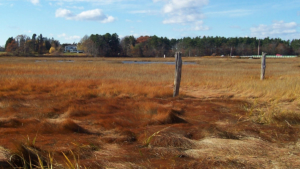The Black Rail (BLRA) is a highly secretive marsh bird believed by researchers to be one of the most endangered birds along the Atlantic Coast. The species once occupied coastal areas from Texas to Massachusetts but has experienced steep annual declines across their breeding range since the 1990s. Conservative estimates of Black Rail populations suggest that only 455 to 1,315 breeding pairs remain – a rangewide decline of >90%!
Little is known about the cause of the population free fall – or how to address it – but sea level rise and coastal development are likely to blame. The species is so secretive and inhabits such inaccessible habitats that it remains one of the least understood species in the Joint Venture. We do know that they have very specific habitat requirements and are generally found in the highest and driest portions of wetland habitats where there is dense overhead vegetation. This high marsh habitat has been highly altered by urban development, marsh ditching and draining, and invasive species while sea level rise is converting much of it to low marsh or open water.
With trends like this, it is critical to move quickly on the most promising conservation actions. One encouraging opportunity for Black Rail conservation is the use of managed impoundments. Properly managed impoundments can be nearly 4 times as likely to attract Black Rail than natural tidal marshes. These habitats may provide critical refugia for Black Rail and the Joint Venture is in search of opportunities to test alternative impoundment management strategies to boost their populations.
The Joint Venture is also seeking funding to develop a Black Rail Conservation Action Plan; fill spatial data gaps; and create habitat priority maps that will help partners to focus their conservation actions where they matter most.
Please contact Aimee Weldon if you would like to be a part of this effort or have ideas for projects on the ground!


